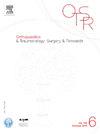Outcomes following anterior cruciate ligament injury with concomitant damage to the medial collateral ligament: an analysis from the registry of the francophone arthroscopic society
IF 2.2
3区 医学
Q2 ORTHOPEDICS
引用次数: 0
Abstract
Introduction
Anterior cruciate ligament (ACL) rupture with concomitant damage to the medial collateral ligament (MCL) is frequently seen following knee trauma. Non-surgical treatment of the MCL lesion generally results in good internal healing, but surgery may be necessary depending on the location of the lesion, the severity, and the laxity.
Objectives
To determine outcomes following ACL reconstruction surgery when there is concomitant damage to the MCL compared to isolated ACL lesions, as assessed through a prospective, multi-center cohort study in France.
Materials and methods
In this prospective, multi-center cohort study, patients who had a primary ACL lesion with or without concomitant damage to the MCL, and who had undergone ACL reconstruction surgery were included. Complications related to the surgery were evaluated prospectively (ACL re-rupture, contralateral rupture, reoperation), and functional scores were obtained until the last follow-up (subjective IKDC, Tegner, ACL-RSI, and SKV).
Results
A total of 722 patients were included in the study: 314 (43.5%) with an isolated ACL lesion and 408 (56.5%) with a combined ACL + MCL lesion. The ACL + MCL group had a significantly higher reoperation rate than the ACL group (7.4% versus 3.2%, p = 0.015). The ACL + MCL group also had mean IKDC and SKV scores at the last follow-up that were significantly poorer than the ACL group (p < 0.0001). High-grade MCL lesions (grade II or III) were identified in 18.2% of cases, and this was found to be predictive of poorer functional scores at the last follow-up. The mean IKDC score was significantly better when non-surgical MCL treatment was possible (p = 0.005). When MCL surgery was indicated, all of the functional scores were significantly better for ligament reinsertion surgery compared to ligament reconstruction.
Conclusion
For combined ACL + MCL lesions, the outcomes are poorer, with a higher reoperation rate and lower functional scores. For high-grade MCL lesions, the functional recovery is poorer, particularly when there are chronic lesions that require multi-ligament reconstruction.
Level of evidence
II; prospective cohort study
前交叉韧带损伤并发内侧副韧带损伤后的预后。
简介:前交叉韧带(ACL)断裂并伴随内侧副韧带(MCL)损伤是膝关节外伤后常见的。MCL病变的非手术治疗通常会导致良好的内部愈合,但根据病变的位置、严重程度和松弛程度,手术可能是必要的。目的:通过法国的一项前瞻性、多中心队列研究,确定与孤立的ACL病变相比,合并MCL损伤的ACL重建手术的结果。材料和方法:在这项前瞻性、多中心队列研究中,纳入了原发前交叉韧带病变伴或不伴中交叉韧带损伤以及行前交叉韧带重建手术的患者。前瞻性评估手术相关并发症(ACL再破裂、对侧破裂、再手术),并在最后一次随访前获得功能评分(主观IKDC、Tegner、ACL- rsi和SKV)。结果:共纳入722例患者,其中314例(43.5%)为孤立ACL病变,408例(56.5%)为ACL + MCL合并病变。ACL + MCL组的再手术率明显高于ACL组(7.4%比3.2%,p = 0.015)。最后一次随访时,ACL + MCL组的平均IKDC和SKV评分也明显低于ACL组(p)。结论:ACL + MCL合并病变的预后较差,再手术率较高,功能评分较低。对于高级别MCL病变,功能恢复较差,特别是当存在需要多韧带重建的慢性病变时。证据等级:II;前瞻性队列研究。
本文章由计算机程序翻译,如有差异,请以英文原文为准。
求助全文
约1分钟内获得全文
求助全文
来源期刊
CiteScore
5.10
自引率
26.10%
发文量
329
审稿时长
12.5 weeks
期刊介绍:
Orthopaedics & Traumatology: Surgery & Research (OTSR) publishes original scientific work in English related to all domains of orthopaedics. Original articles, Reviews, Technical notes and Concise follow-up of a former OTSR study are published in English in electronic form only and indexed in the main international databases.

 求助内容:
求助内容: 应助结果提醒方式:
应助结果提醒方式:


